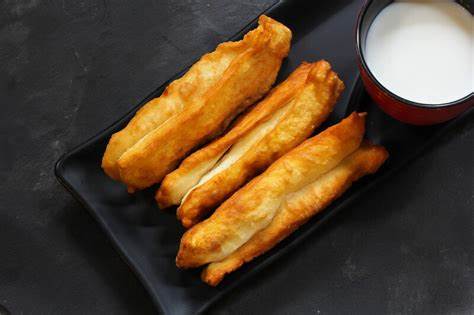Hangzhou, a city known for its signature dishes like Dongpo Pork, Xindeng Biscuits, and Hangzhou Soy Duck, holds a little-known secret about a staple breakfast item: the humble youtiao (fried dough stick). Originating from the serene and poetic Jiangnan region, youtiao has a rich history entwined with a tale of resistance and anger.
The Historical Roots of Youtiao
According to the ‘Song History’, youtiao dates back to the Southern Song Dynasty, where it was originally called ‘You Zha Gui’. During this time, Qin Hui, a much-loathed figure among the populace, became the unintended target of culinary satire. In West Lake’s vicinity, two food vendors crafted dough figures resembling Qin Hui and his wife Wang Shi, twisted them together, and fried them in hot oil. These dough figures were named ‘You Zha Gui’. As word spread, people reveled in consuming these fried dough sticks as a means to vent their frustrations.

The fried delicacy not only served as a symbolic outlet for the public’s disdain towards Qin Hui but also proved to be delicious and affordable. Over time, its shape evolved into long strips, hence the name youtiao. Some regions in China still refer to youtiao as ‘You Zha Gui’ to this day.
A Morning Ritual
In Hangzhou, the aroma of freshly fried youtiaos fills the streets every morning, enticing residents to start their day with this crispy, golden delight. Pairing youtiao with a savory cup of soy milk or a warm bowl of rice porridge creates a perfect, satisfying breakfast that embodies the very essence of local cuisine.

The Upgraded Version: Cong Bao Hui
Not content with merely frying ‘Qin Hui and Wang Shi’, locals also took their culinary creativity a step further with the invention of ‘Cong Bao Hui’. This dish involved flattening dough, cutting it into pieces, and frying it again to ‘chop them into bits’. The resulting flatbread, grilled until golden on both sides, is garnished with scallions and sweet sauce, offering a delightful aroma and flavor that’s both savory and symbolic of the people’s enduring resentment.
While youtiao and Cong Bao Hui are now widely enjoyed by people of all ages, the stories behind their origins remind us of the historical context and the depths of sentiment intertwined with these seemingly simple foods. The legacy of these dishes serves as a poignant reminder that food is a vessel of history and emotion, transcending mere taste to convey powerful narratives.

